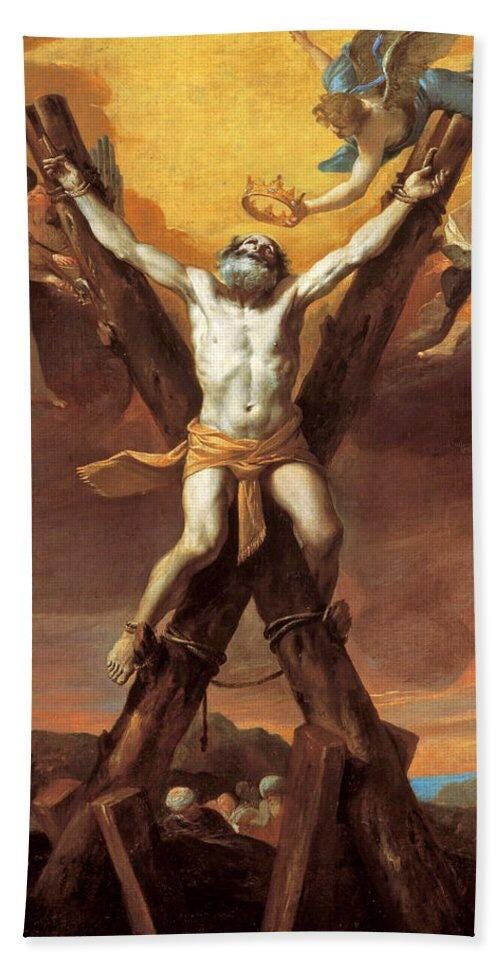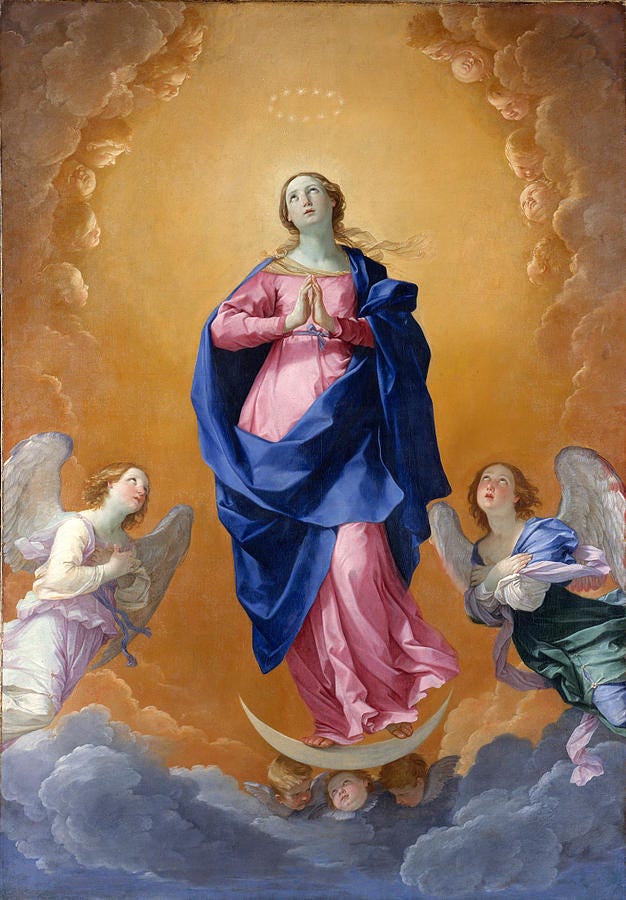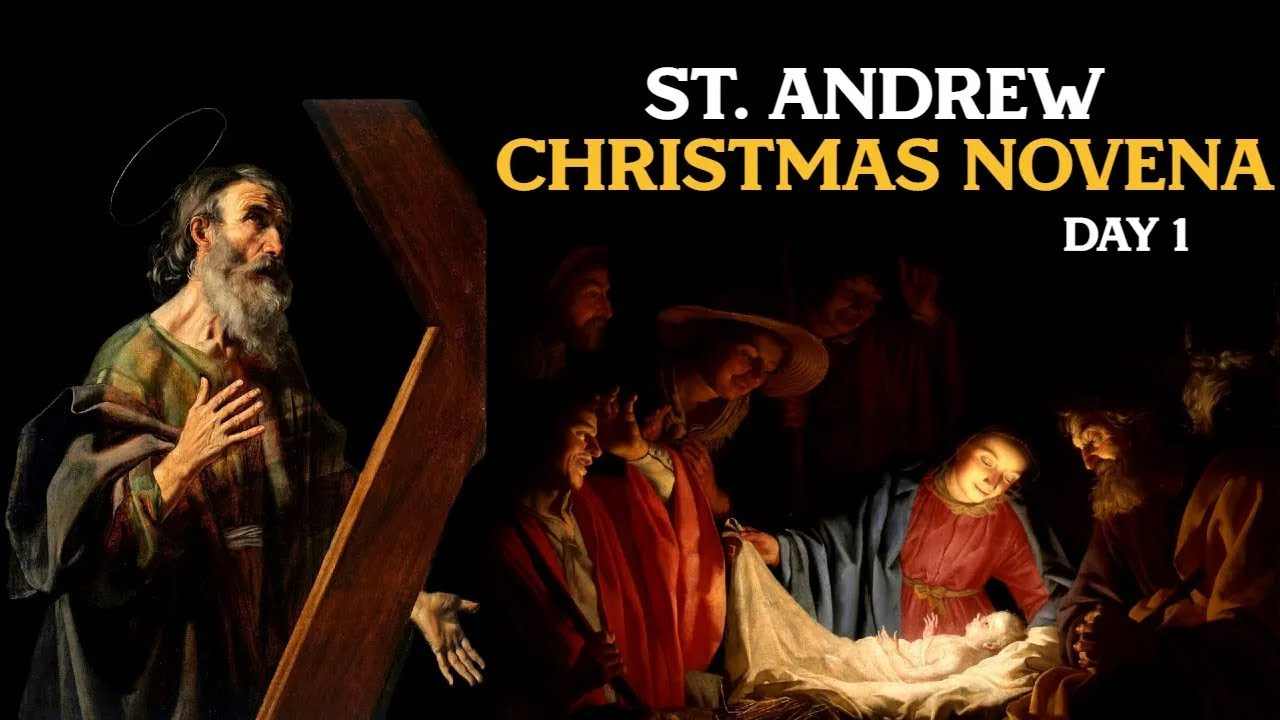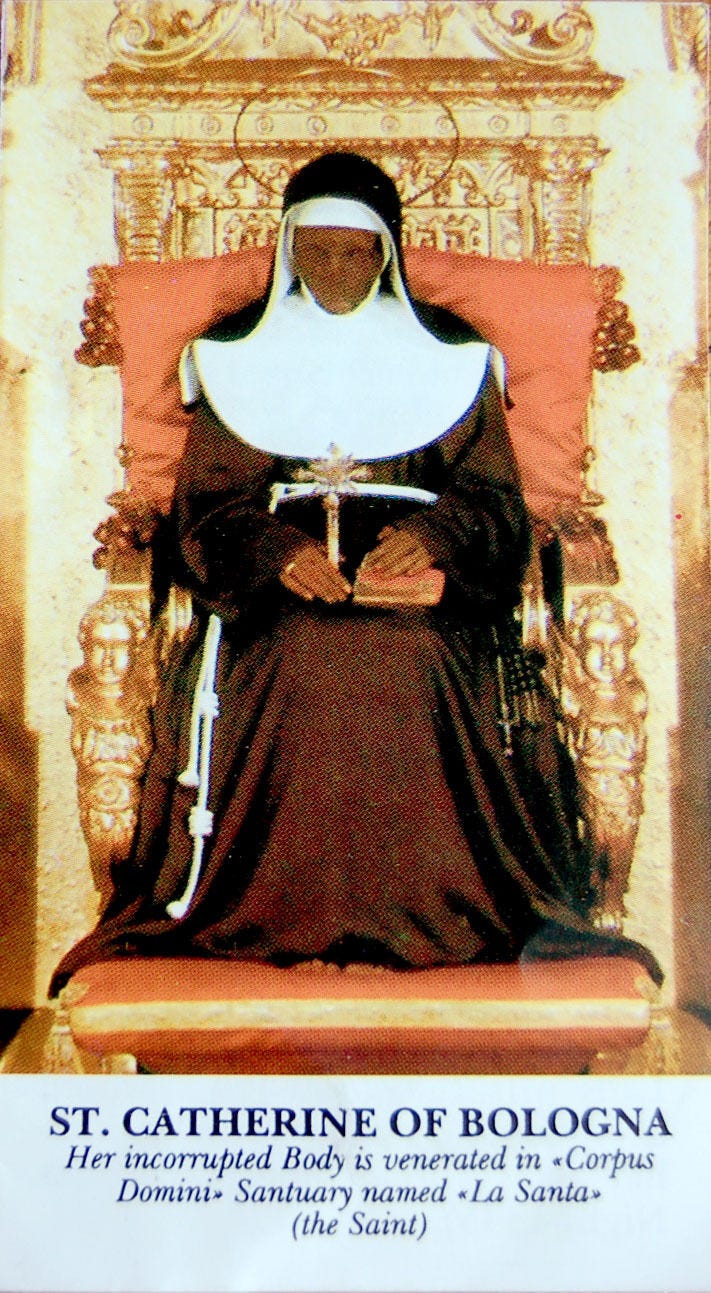The beginning of Advent is the time to set up your Nativity scene ("presepio" in Italian, "crèche" in French). All of the figures are set out but for Baby Jesus; the manger itself should be left empty until Christmas Eve, when Baby Jesus arrives at midnight. This sets up a mood of anticipation; everything is in place -- but He has not yet come. Some families have a tradition of "preparing the manger" by allowing the children each evening to place a single piece of straw for each good deed they've done during the day. By the time Christmas Eve comes, Jesus will have a soft bed to lie in.
The presepio, then, becomes a scene of drama, and just as the crib is empty until Christmas Eve when Baby Jesus is added, the Three Kings should be kept away from the manger and moved closer and closer until they finally reach it, not on Christmas, but on the Eve of the Feast of the Epiphany (Twelfthnight) which begins the celebration of Our Lord's showing His divinity to the wise men. Some families might start with the Magi in a totally different room and move them closer and closer each night. When they finally arrive on Twelfthnight, Baby Jesus can be crowned and adorned in purple, the color of royalty. The St. Barbara's Day custom of forcing branches of cherry trees to blossom (or germinating wheat, as per the French practice) comes into play with regard to the creche, too: the blossoms are used to adorn the crib throughout the Christmas season.
The first presepio was created by St. Francis of Assisi when he recreated the scene of Christ's Nativity in Greccio, Italy, on Christmas Eve of A.D. 1223. This, according to the Catholic Encyclopedia, is the first instance of a Mystery Play in Italy. The Saint's first biographer, Bl. Thomas of Celano (d. ca. A.D. 1255), describes the scene:
There was in that place a certain man named John, of good reputation and even better life, whom the blessed Francis particularly loved. Noble and honorable in his own land, he had trodden on nobility of the flesh and pursued that of the mind. Around fifteen days before the birthday of Christ Francis sent for this man, as he often did, and said to him, "If you wish to celebrate the approaching feast of the Lord at Greccio, hurry and do what I tell you. I want to do something that will recall the memory of that child who was born in Bethlehem, to see with bodily eyes the inconveniences of his infancy, how he lay in the manger, and how the ox and ass stood by." Upon hearing this, the good and faithful man hurried to prepare all that the holy man had requested.
The day of joy drew near, the time of exultation approached. The brothers were called from their various places. With glad hearts, the men and women of that place prepared, according to their means, candles and torches to light up that night which has illuminated all the days and years with its glittering star. Finally the holy man of God arrived and, finding everything prepared, saw it and rejoiced.
The manger is ready, hay is brought, the ox and ass are led in. Simplicity is honored there, poverty is exalted, humility is commended and a new Bethlehem, as it were, is made from Greccio. Night is illuminated like the day, delighting men and beasts. The people come and joyfully celebrate the new mystery. The forest resounds with voices and the rocks respond to their rejoicing. The brothers sing, discharging their debt of praise to the Lord, and the whole night echoes with jubilation. The holy man of God stands before the manger full of sighs, consumed by devotion and filled with a marvelous joy. The solemnities of the mass are performed over the manger and the priest experiences a new consolation.
The holy man of God wears a deacon's vestments, for he was indeed a deacon, and he sings the holy gospel with a sonorous voice. And his voice, a sweet voice, a vehement voice, a clear voice, a sonorous voice, invites all to the highest rewards. Then he preaches mellifluously to the people standing about, telling them about the birth of the poor king and the little city of Bethlehem. Often, too, when he wished to mention Jesus Christ, burning with love he called him "the child of Bethlehem," and speaking the word "Bethlehem" or "Jesus," he licked his lips with his tongue, seeming to taste the sweetness of these words.
The gifts of the Almighty are multiplied here and a marvelous vision is seen by a certain virtuous man. For he saw a little child lying lifeless in the manger, and he saw the holy man of God approach and arouse the child as if from a deep sleep. Nor was this an unfitting vision, for in the hearts of many the child Jesus really had been forgotten, but now, by his grace and through his servant Francis, he had been brought back to life and impressed here by loving recollection. Finally the celebration ended and each returned joyfully home.
The hay placed in the manger was kept so that the Lord, multiplying his holy mercy, might bring health to the beasts of burden and other animals. And indeed it happened that many animals throughout the surrounding area were cured of their illnesses by eating this hay. Moreover, women undergoing a long and difficult labor gave birth safely when some of this hay was placed upon them. And a large number of people, male and female alike, with various illnesses, all received the health they desired there. At last a temple of the Lord was consecrated where the manger stood, and over the manger an altar was constructed and a church dedicated in honor of the blessed father Francis, so that, where animals once had eaten hay, henceforth men could gain health in soul and body by eating the flesh of the Lamb without spot or blemish, Jesus Christ our Lord, who through great and indescribable love gave himself to us, living and reigning with the Father and Holy Spirit, God eternally glorious forever and ever, Amen. Alleluia! Alleluia!
St. Bonaventure, who wrote another biography of St. Francis,1 described the institution of the crib like this:
Now three years before his death it befell that he was minded, at the town of Greccio, to celebrate the memory of the Nativity of the Child Jesus, with all the added solemnity that he might, for the kindling of devotion. That this might not seem an innovation, he sought and obtained license from the Supreme Pontiff, and then made ready a manger, and bade that hay, together with an ox and ass, be brought unto the spot. The friars were called together, the folk assembled, the wood echoed with their voices, and that august night was made radiant and solemn with many bright lights, and with tuneful and sonorous praises. The man of God, filled with tender love, stood before the manger, bathed in tears, and overflowing with joy.
Solemn Masses were celebrated over the manger, Francis, the levite of Christ, chanting the Holy Gospel. Then he preached unto the folk standing around at the Birth of the King of poverty, calling Him, when he wished to name Him, the Child of Bethlehem, by reason of his tender love for Him. A certain knight, valorous and true, Messer Giovanni di Greccio, who for the love of Christ had left the secular army and was bound by closest friendship unto the man of God, declared that he beheld a little Child right fair to see, sleeping in that manger, who seemed to be awakened from sleep when the blessed Father Francis embraced Him in both arms. This vision of the devout knight is rendered worthy of belief, not alone through the holiness of him that beheld it, but is also confirmed by the truth that it set forth, and withal proven by the miracles that followed it. For the example of Francis, if meditated upon by the world, must needs stir up sluggish hearts unto the faith of Christ; for even the hay that was taken from the manger by the folk proved a marvellous remedy for sick beasts, and a preventative against divers other plagues, God magnifying by all means His servant, and making manifest by clear and miraculous portents the efficacy of his holy prayers.In Naples, presepi are extremely elaborate. You'll find figures to represent each month: a butcher for January; a cheesemaker for February; a poultry-seller for March; an egg-seller for April; a cherry-seller for May; a baker for June; a tomato vendor for July; a watermelon seller for August; a farmer for September; a wine-seller for October; a chestnut-seller for November; and a fishmonger for December.
You'll also invariably find a shepherd-bagpiper, or "zampognaro." The zampognari figures are based on the Italian tradition of the shepherds' (especially of Abruzzi and Lazio) coming down from the mountains at Christmastime, going door-to-door to play bagpipes to announce the birth of Christ. This tradition continues today, and is so beloved that the zampognaro appears in Italian presepi, sometimes accompanied by the pifferai (flute players) that often accompany the pipers in real life.1
We hope you had a Blessed Feast Day of St Andrew the Apostle, “the ‘Strong Man’ who Carries the Year (check out this beautiful Ad Rem by Brother Andre Marie on the end of the Liturgical Year).
What determines the first Sunday of Advent, the very beginning of the Church’s Liturgical Year? In the Roman Rite, it is very simply the Sunday nearest to the feast of Saint Andrew, November 30. The first Sunday of Advent can occur either before or after November 30; the formula is that it is the closest Sunday. There is something appropriate here. Saint Andrew is the Protoclete, the “First Called,” as he is named in the East. He was the first of Saint John the Baptist’s disciples to follow Our Lord and he, in turn, brought his brother, Simon, to do the same: “We have found the Messias…. And he brought him to Jesus” (John 1:41-42). It was then that Jesus told Simon he would become Peter. Andrew’s name comes from the Greek word for man. He is to the liturgical year what Atlas is to the celestial spheres in Greek mythology; the manly Protoclete holds the liturgical year, as it were, on his shoulders.”2
Holy Mother Church in Her infinite wisdom gives us this wonderful Feast Day as a marker to begin two beautiful Novenas to thrust us headfirst into the new liturgical year. In addition, since December is dedicated to the Immaculate Conception of Mary, we hope you will join us in playing the Magnificat each day this month.
My soul proclaims the greatness of the Lord,
my spirit rejoices in God my Savior
for he has looked with favor on his lowly servant.
From this day all generations will call me blessed:
the Almighty has done great things for me,
and holy is his Name.He has mercy on those who fear him
in every generation.
He has shown the strength of his arm,
he has scattered the proud in their conceit.He has cast down the mighty from their thrones,
and has lifted up the lowly.
He has filled the hungry with good things,
and the rich he has sent away empty.He has come to the help of his servant Israel
for he remembered his promise of mercy,
the promise he made to our fathers,
to Abraham and his children forever.(Lk 1: 46-55)
Today also commences the opportunity to begin the two aforementioned Novenas that will take you through Christmas Eved5fyr.
The first is commonly known as the St Andrew’s Christmas Novena because it begins on the aforementioned Saint’s Feast Day…
Say 15 times a day from St. Andrew’s Day (30 November), ending on Christmas Eve
Hail, and blessed be the hour and moment at which the Son of God was born of a most pure Virgin at a stable at midnight in Bethlehem in the piercing cold. At that hour vouchsafe, I beseech Thee, to hear my prayers and grant my desires. (Mention your intentions here) Through Jesus Christ and His most Blessed Mother.
The final Novena you may begin today is the lesser known St. Catherine of Bologna 1,000 Hail Marys Christmas Devotion.
On Christmas 1445, St. Catherine of Bologna asked the superior for permission to spend that night in prayer. She wished to offer a thousand Hail Marys in honour of the Mother of God.
At midnight, Our Lady appeared to her, holding the Child Jesus close to her breast. The Virgin placed the Child in the arms of the Saint, from whose heart overflowed ardent acts of affection and tenderness. The virginal lips of the nun touched the face of the Child, who, in response to the love of his spouse, also gave her a kiss.
Tradition tells us that the white mark which remained on St. Catherine’s incorrupt body indicates the exact spot where Jesus affectionately kissed her. In memory of this fact, to this day the people of Bologna observe the custom of reciting a thousand Hail Marys on Christmas Eve or 40 Hail Marys per day in the 25 days leading up to Christmas from November 30th through December 24th.
https://fisheaters.com/adventcribs.html
https://catholicism.org/ad-rem-no-450.html







